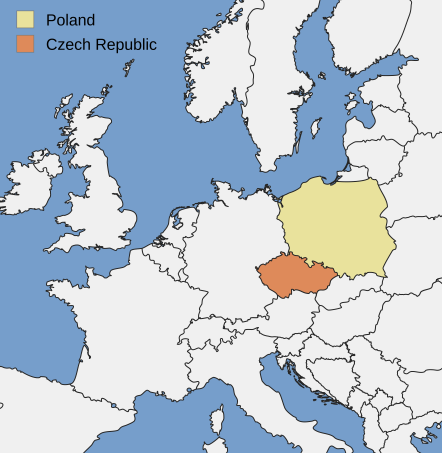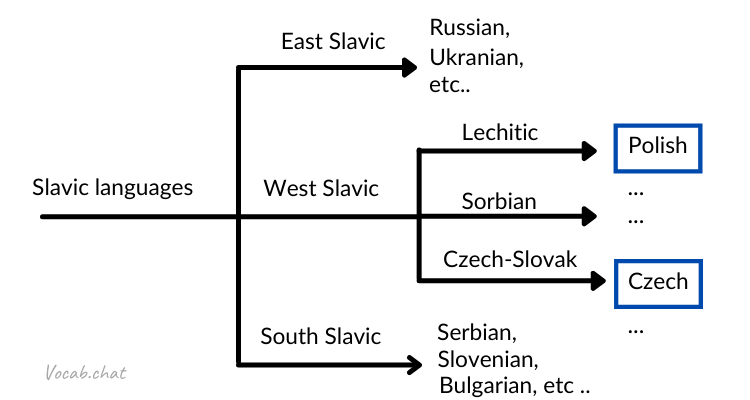Are Polish and Czech Similar or really Different?

Poland and the Czech Republic are neighboring countries with a border in common. It’s easy to travel from Warsaw (the capital of Poland) to Prague (the capital of the Czech Republic) and vice-versa. There’s even a night train with sleeping cars on that route.
This proximity makes travelers wonder if Polish and Czech are similar languages. Well, first of all, they are both Slavic languages —but that’s not all.
Slavic languages, such as Polish, Czech, Slovak, and Russian, are divided into three subgroups: South Slavic, East Slavic, and West Slavic languages.
Polish and Czech belong to the same subgroup because they are both West Slavic languages. This means that they are very closely related, and therefore, they share a lot of similarities.
But, how similar are they? What are the differences between them? These are the questions that we will answer in this article. We also included some audio recordings so that you can hear the differences in pronunciation between Polish and Czech.
Origins of Polish and Czech
To understand the relationship between Polish and Czech, it helps to know the origin of these languages. Both evolved from the Proto-Indo-European language, a now-extinct language that existed several thousand years ago in Central Europe and Central Asia.
Like Polish and Czech, most European languages originate from Proto-Indo-European. Although, there are a few exceptions, such as Finnish, Hungarian, and Estonian.

As a result of tribe migrations, the Proto-Indo-European language evolved and split into several dialects, which then turned into separate languages. That is how the Slavic language group came to be. It now consists of three subgroups: West Slavic, East Slavic, and South Slavic languages.
West Slavic languages are further divided into three smaller groups: Czech-Slovak, Lechitic, and Sorbian. The Czech language is part of the Czech-Slovak subgroup together with Slovak (which is why Czech and Slovak are mutually intelligible), while Polish belongs to the Lechitic group.
Polish and Czech are languages that almost disappeared entirely due to historical events. In the 17th century, the Czech language faced a near-extinction after the outbreak of a thirty-year religious war. Due to the war, the population of the Czech Republic fell significantly, together with the linguistically-gifted elite.
Despite that, the Czech language stayed alive in the countryside, being taught from one generation to another, mostly in speech. Although the language lingered in the minds of the Czech population, it wasn’t fully revived until the 18th century.
As for the Polish language, the history was very similar. Poland had endured a tough period of 123 years when it completely vanished from the map of the world due to the Third Partition of Poland in 1795 by three power nations: Austria, Prussia, and Russia.
During that time, it was forbidden to use the Polish language, and anyone who dared to use it publicly faced legal consequences. Despite the adversities, the Polish people kept the language alive. Poland regained its independence in 1918, and the Polish language was revived.
Nowadays, approximately 11.5 million people speak the Czech language, out of which 10 million are Czech Republic residents. It is most closely related to Slovak and then also to Polish, Kashubian, and Lusatian.
Polish is spoken by approximately 44 million people worldwide, mainly by Polish residents and Polish people living abroad. It is the sixth most spoken language of the European Union and one of its official languages.
How Polish and Czech influenced each other
Poland and the Czech Republic are neighboring countries that share a border. Their languages, Polish and Czech, developed alongside each other, and some vocabulary similarities result from historical events.
Poland adopted Christianity through the Czech Republic in 966, when the first Polish King - Mieszko I - married a Czech woman called Dobrawa (Doubravka in Czech) from the Přemyslid dynasty.
In addition to Christianity, this international union also introduced new vocabulary terms into Polish. Many words in Polish originate from the Czech language, such as Polish “kościół”, which comes from the Czech “kostel” and means “a church”.
Later in the Middle Ages, Czech became very popular in Poland. Many people in intellectual circles spoke Czech, which created a fashion for the Czech language and led to many lexical changes in the Polish language.
For example, Polish words that contain the particle “ra” or “ła” between the consonants, such as “brama” (gate) or “błagać” (to beg), typically originate from the Czech language.
Are Polish and Czech Mutually Intelligible?
When two languages are mutually intelligible, it means that speakers of one can easily understand the other without needing to learn it.
Although Polish and Czech belong to the same subgroup of Slavic languages and share many similarities, they are not mutually intelligible. Linguists claim Czech’s oral intelligibility with Polish is only 36% and written intelligibility 46%.
However, Poles and Czechs can learn to understand each other’s language exceptionally quickly based on how much exposure to that language they are experiencing.
This is why many Polish people who live close to the border with the Czech Republic can easily understand Czechs and vice versa.
Is Polish or Czech easier to learn for anglophones?
Although Polish and Czech may have a lot in common, there is no doubt that they are incredibly different from the English language. Both Polish and Czech share complex grammar that differs a lot from English grammar.
They are both hard to pronounce for an English speaker with lots of sounds that simply do not exist in English, and their vocabulary has nothing in common with the English vocabulary.
What’s more, both Polish and Czech are categorized as level IV languages according to The Foreign Service Institute. This means that learning them at a basic conversational level requires at least 1,100 hours of study (or 44 weeks).
However, if you already have some background in another Slavic language, or you’re just a language lover who finds it easy to learn foreign languages, learning Polish and Czech may not be so difficult for you.
Similarities between Polish and Czech
Although we cannot say that Polish and Czech are identical or even mutually intelligible, there is no doubt that they share many similarities. Coming from the same language group and subgroup, these two languages share a similar grammatical structure and vocabulary.
With that said, let’s take a look at the similarities between Polish and Czech more closely.
1. Grammatical structure.
Polish and Czech follow a very similar general grammatical structure. For example, both of these languages use declension.
Declension, which is entirely unfamiliar to any English speaker, is a complex system of grammatically determined modifications of nouns, adjectives, pronouns, and numerals.
Both Polish and Czech have seven cases: nominative, genitive, dative, accusative, instrumental, locative, and vocative. They also share many similarities in the conjugation of verbs, the use of tenses, or the use of prepositions.
2. Lexical overlap.
The most prominent similarities between Polish and Czech are in their vocabulary. The similarities in the lexical development of these languages are caused by the inheritance of words from the Proto-Slavic language (which is one of the dialects the Proto-Indo-European language developed into during tribe migrations).
It is estimated that Polish adopted approximately 1,700 words from the Proto-Slavic language. In comparison, the Czechs incorporated about 2,000 words into their vocabulary - most of which are words common to both languages.
Here are a few words and expressions that sound very similar in Polish and Czech:
- “Bird” is
“ptak” in Polish and
“pták” in Czech.
Therefore, the phrase “This bird sings beautifully” is “Ten ptak pięknie śpiewa” in Polish and “Tento pták krásně zpívá.” in Czech. - “Milk” is
“mleko” in Polish and
“mléko” in Czech.
Therefore, the phrase “There is no milk at home.” is “W domu nie ma mleka” in Polish and “Doma není mléko.” in Czech. - “It’s true” is “to prawda” in Polish and “to je pravda” in Czech.
- “I’m coming home” is “wracam do domu” in Polish and “vracím se domů” in Czech
- “Red wine” is “czerowne wino” in Polish and “červené víno” in Czech.
Differences between Polish and Czech
Let’s take a look at some significant differences between Polish and Czech.
1. Phonetics.
Although Polish and Czech may sound almost indistinguishable to a foreign ear, the most significant differences between these two languages lie in their phonetics.
To start with, the Polish consonant system is relatively complex, while the Czech version is fairly simple.
On the other hand, the vowel system in Polish is straightforward (it has only six oral monophthongs and two nasals). In contrast, the Czech vowel system is more developed (it has ten monophthongal and three diphthongal vowel phonemes).
What’s more, the Czech language does not have nasal vowels as Polish does. Czech distinguishes long and short vowels, while Polish doesn’t. Additionally, Polish preserved the phonetic difference between 'i' and 'y', while in Czech, they have merged into one single vowel.
Another big difference in how these two languages sound is the pronunciation stress. In Polish, the stress is usually put on the next-to-last syllable, while in Czech, the first syllable of a word is stressed.
2. Grammatical modifications.
Although Polish and Czech follow the same grammatical structure, there are some differences in the details.
For example, both Polish and Czech use declension of nouns, pronouns, adjectives, numerals, and the conjugation of verbs, but their grammatical modifications differ significantly.
The sentence syntax also differs between these two languages as the word order in Czech sentences is not precisely the same as in Polish sentences.
3. Polish-Czech Vocabulary False Friends.
Although Polish and Czech share a considerable percentage of their vocabulary, there are also many significant differences that Poles and Czechs need to pay attention to when communicating with each other!
You may often hear Poles and Czechs telling stories of how using similar-sounding words in each other’s languages created funny situations and complete misunderstandings. This is because Polish and Czech have a lot of false friends: words that sound similar but are very different in meaning.
For example, in Polish, the word “zachód” means West, while the very similar-sounding “záchod” means toilet in Czech!
Another funny example is the Czech word “divadlo”, which simply means “theatre”. Whereas In Polish, the word “dziwadło” means “a freak”!
Here are some examples of false friends in Polish and Czech:
- The word “čerstvý” means “fresh” in Czech, while the Polish equivalent “czerstwy” means “stale”.
- The word “nápad” means “idea” in Czech, while the Polish equivalent “napad” means “an attack”.
- The word “sklep” means “basement” in Czech. In Polish, the exact same word ( “sklep”) means “a shop”! On the other hand, the word “piwnica” means “basement” in Polish, while in Czech, it means “a beerhouse”!
- The word “láska” in Czech means “love”, while the Polish equivalent “laska” means “a cane” or, casually, an attractive young woman.
4. Spelling and orthography.
There are also significant differences in the spelling and orthography of the Polish and Czech languages.
First, the Czech language has diacritic marks unknown to the Polish language. For example, the Czech language uses a dash (called čárka in Czech) that appears above vowels and marks the length of the vowel above which it appears.
A dash in Polish is placed above certain consonants (ć, ń, ś, ź, dź) to denote their softness. The only vowel that appears with a dash is “ó”, pronounced the same way a “u” is. In comparison, in Czech, the vowel “u” is marked in two ways: either with a dash (ú) or with a circle (ů).
Another critical difference is that the Czech language uses the so-called “hook” (from Czech “háček”) above certain consonants (č, ň, ř, š, ž) and the vowel “ě”. This doesn’t exist in the Polish language.
The Czech letters with hooks have the following equivalents in Polish: “č” is Polish “cz,” “ř” is the equivalent of “rz,” “š” corresponds to “sz,” “ž” corresponds to “ż,” and “ň” to “ń.”
ConclusionMost people believe that Polish and Czech are two very similar, almost identical, languages. It may be practically impossible to distinguish between these two Slavic languages to an untrained ear.
While it’s true that Polish and Czech developed simultaneously and share a lot of similarities, such as their grammatical structure and vocabulary, many differences between them make them into two completely separate languages.
To continue learning about the similarities and differences between Czech and Polish, have a look at these lists of the 1000 most common Czech words, and the 1000 most common Polish words.
References:- [1] (Map license)
